Papers by Bento Fortunato Cardoso dos Santos
Artificial Organs, 2004
CARDIOLOGY P1 Impact of peroperative administration of steroid over inflammatory response and pul... more CARDIOLOGY P1 Impact of peroperative administration of steroid over inflammatory response and pulmonary dysfunction following cardiac surgery

Renal medullary cells are exposed to elevated and variable osmolarities and low oxygen tension. D... more Renal medullary cells are exposed to elevated and variable osmolarities and low oxygen tension. Despite the harsh environment, these cells are resistant to the effects of many harmful events. To test the hypothesis that this resistance is a consequence of these cells developing a stress tolerance phenotype to survive in this milieu, we created osmotically tolerant cells (HT cells), by gradually adapting mIMCD3 cells to hyperosmotic medium containing NaCl and urea. HT cells have a reduced DNA synthesis rate, with the majority of cells arrested in the G0/G1 phase of the cell cycle and show constitutive expression of Hsp70 that is proportional to the degree of hyperosmolarity. Unlike acute, chronic hyperosmolarity failed to activate MAPKs. Moreover, HT cells acquired protein translational tolerance to further stress treatment, suggesting that HT cells have an osmotolerant phenotype, analogous to thermotolerance, but a permanent condition. Additionally to osmotic shock, HT cells were mo...

Blood Purification
Background: Critically ill patients with COVID-19 may develop multiple organ dysfunction syndrome... more Background: Critically ill patients with COVID-19 may develop multiple organ dysfunction syndrome, including acute kidney injury (AKI). We report the incidence, risk factors, associations, and outcomes of AKI and renal replacement therapy (RRT) in critically ill COVID-19 patients. Methods: We performed a retrospective cohort study of adult patients with COVID-19 diagnosis admitted to the intensive care unit (ICU) between March 2020 and May 2020. Multivariable logistic regression analysis was applied to identify risk factors for the development of AKI and use of RRT. The primary outcome was 60-day mortality after ICU admission. Results: 101 (50.2%) patients developed AKI (72% on the first day of invasive mechanical ventilation [IMV]), and thirty-four (17%) required RRT. Risk factors for AKI included higher baseline Cr (OR 2.50 [1.33–4.69], p = 0.005), diuretic use (OR 4.14 [1.27–13.49], p = 0.019), and IMV (OR 7.60 [1.37–42.05], p = 0.020). A higher C-reactive protein level was an ad...

Background: Acute kidney injury is a common complication in solid organ transplants, notably live... more Background: Acute kidney injury is a common complication in solid organ transplants, notably liver transplantation. The MELD is a score validated to predict mortality of cirrhotic patients, which is also used for organ allocation, however the influence of this allocation criteria on AKI incidence and mortality after liver transplantation is still uncertain.Methods: This is a retrospective single center study of a cohort of patients submitted to liver transplant in a tertiary Brazilian hospital: Jan/2002 to Dec/2013, divided in two groups, before and after MELD implementation (pre MELD and post MELD). We evaluate the differences in AKI based on KDIGO stages and mortality rates between the two groups. Results: 874 patients were included, 408 in pre-MELD and 466 in the post MELD era. The proportion of patients that developed AKI was lower in the post MELD era (p 0.04), although renal replacement therapy requirement was more frequent in this group (p<0.01). Overall mortality rate at ...

The International Journal of Artificial Organs
Background/Aims: Continuous renal replacement therapies (CRRT) are initially employed in patients... more Background/Aims: Continuous renal replacement therapies (CRRT) are initially employed in patients with acute kidney injury (AKI) in ICU setting. After the period of serious illness, hemodialysis is usually used as a mode of transition from CRRT. Intermittent hemodiafiltration (HDF) is not commonly applied in this scenario. Objectives: To evaluate the feasibility of using HDF as transition therapy after CVVHDF in critically patients with AKI. Methods: An observational and prospective pilot study was conducted in ICU patients with dialysis-requiring AKI. Patients were initially treated with CVVHDF and, after medical improvement, those who still needed renal replacement therapy were switched to HDF treatment. Results: Ten Patients underwent 53 HDF sessions (mean of 5.3 sessions/patient). The main cause of renal dysfunction was sepsis ( N = 7; 70%). The APACHE II mean score was 27.6 ± 6.9. During HDF treatment, the urea reduction ratio was 64.5 ± 7.5%, for β-2 microglobulin serum levels...
Critical Care
Objectives: In the treatment of acute myocardial infarction (MI), the time delay to achieve reper... more Objectives: In the treatment of acute myocardial infarction (MI), the time delay to achieve reperfusion of the infarction-related artery has been linked to survival rates. Primary or direct angioplasty has been found to be an excellent means of achieving reperfusion in acute ST-elevation MI compared to thrombolytic therapy in randomized trials. However, no mortality benefit of primary angioplasty over thrombolysis was observed in several registries, in which delays in performing primary angioplasty were longer. Our objectives were to evaluate the door-to-balloon time (DBT) in our institution and investigate its relationship with clinical and prognostic variables.

Medicine, 2018
Metabolic acid-base disorders, especially metabolic acidosis, are common in critically ill patien... more Metabolic acid-base disorders, especially metabolic acidosis, are common in critically ill patients who require renal replacement therapy. Continuous veno-venous hemodiafiltration (CVVHDF) achieves profound changes in acid-base status, but metabolic acidosis can remain unchanged or even deteriorate in some patients. The objective of this study is to understand the changes of acid-base variables in critically ill patients with septic associated acute kidney injury (SA-AKI) during CVVHDF and to determine how they relate to clinical outcome.Observational study of 200 subjects with SA-AKI treated with CVVHDF for at least 72 hours. Arterial blood gases and electrolytes and other relevant acid-base variables were analyzed using quantitative acid-base chemistry.Survivors and nonsurvivors had similar demographic characteristics and acid-base variables on day one of CVVHDF. However, during the next 48 hours, the resolution of acidosis was significantly different between the 2 groups, with an...
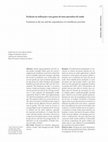
Ciência & Saúde Coletiva
Resumo O envelhecimento da população e o crescimento no número de pessoas expostas aos cuidados d... more Resumo O envelhecimento da população e o crescimento no número de pessoas expostas aos cuidados do sistema de saúde suplementar no Brasil aumentam a preocupação dos gestores públicos e privados com o crescimento dos custos da área de saúde. Neste trabalho foram analisados os custos por gênero, por tipo de gasto médico e por faixa etária de uma operadora de autogestão brasileira no período entre 2007 a 2013. Tal operadora é de grande interesse pois além de retratar uma condição única de restrição de crescimento de receita, também replica o perfil demográfico esperado para o Brasil no ano de 2050, quando aproximadamente um terço da sua população estará acima dos 60 anos. As análises corroboram a literatura vigente uma vez que demonstram um aumento na utilização do plano pelos mais idosos, e apontam para uma diferença nas taxas de internação entre os gêneros. O estudo também mostra um expressivo aumento no tempo médio de permanência nos hospitais e mostra crescimento dos gastos médicos...
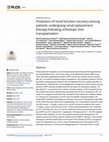
PloS one, 2017
Renal dysfunction frequently occurs during the periods preceding and following orthotopic liver t... more Renal dysfunction frequently occurs during the periods preceding and following orthotopic liver transplantation (OLT), and in many cases, renal replacement therapy (RRT) is required. Information regarding the duration of RRT and the rate of kidney function recovery after OLT is crucial for transplant program management. We evaluated a sample of 155 stable patients undergoing post-intensive care hemodialysis (HD) from a patient population of 908 adults who underwent OLT. We investigated the average time to renal function recovery (duration of RRT required) and determined the risk factors for remaining on dialysis > 90 days after OLT. Log-rank tests were used for univariate analysis, and Cox proportional hazards models were used to identify factors associated with the risk of remaining on HD. The results of our analysis showed that of the 155 patients, 28% had pre-OLT diabetes mellitus, 21% had pre-OLT hypertension, and 40% had viral hepatitis. Among the patients, the median MELD (...

BMC nephrology, Jan 3, 2017
Many controversies exist regarding the management of dialysis-requiring acute kidney injury (D-AK... more Many controversies exist regarding the management of dialysis-requiring acute kidney injury (D-AKI). No clear evidence has shown that the choice of dialysis modality can change the survival rate or kidney function recovery of critically ill patients with D-AKI. We conducted a retrospective study investigating patients (≥16 years old) admitted to an intensive care unit with D-AKI from 1999 to 2012. We analyzed D-AKI incidence, and outcomes, as well as the most commonly used dialysis modality over time. Outcomes were based on hospital mortality, renal function recovery (estimated glomerular filtration rate-eGFR), and the need for dialysis treatment at hospital discharge. In 1,493 patients with D-AKI, sepsis was the main cause of kidney injury (56.2%). The comparison between the three study periods, (1999-2003, 2004-2008, and 2009-2012) showed an increased in incidence of D-AKI (from 2.56 to 5.17%; p = 0.001), in the APACHE II score (from 20 to 26; p < 0.001), and in the use of cont...
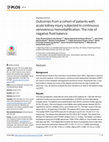
PloS one, 2017
Several factors influence the outcomes in acute kidney injury (AKI), especially in intensive care... more Several factors influence the outcomes in acute kidney injury (AKI), especially in intensive care unit (ICU) patients. In this scenario, continuous renal replacement therapies (CRRT) are used to control metabolic derangements and blood volume. Knowing this fact, it may be possible to change the course of the disease and decrease the high mortality rate observed. Thus, we aimed to evaluate the main risk factors for death in AKI patients needing CRRT. This was a prospective, observational cohort study of ICU patients (N = 183) with AKI who underwent continuous venovenous hemodiafiltration (CVVHDF) as their initial dialysis modality choice. The patients were predominantly male (62.8%) and their median age was 65 (55-76) years. The most frequent comorbidities were cardiovascular disease (39.3%), hypertension (32.8%), diabetes (24%), and cirrhosis (20.7%). The main cause of AKI was sepsis (52.5%). At beginning of CVVHDF, 152 patients (83%) were using vasopressors. The median SAPS 3 and S...
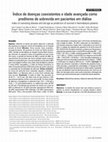
Einstein, 2007
Índice de doenças coexistentes e idade avançada como preditores de sobrevida em pacientes em diál... more Índice de doenças coexistentes e idade avançada como preditores de sobrevida em pacientes em diálise ARTIGO ORIGINAL RESUMO Objetivos: Identificar os fatores que podem influenciar a sobrevida dos pacientes em programa crônico de hemodiálise em um hospital privado do Brasil. Métodos: Neste estudo, foram avaliados, retrospectivamente, 99 pacientes do Centro de Diálise Einstein (CDE), Unidade de Hemodiálise do Hospital Israelita Albert Einstein, que estiveram em programa crônico de hemodiálise por pelo menos três meses, no período de fevereiro de 2000 a outubro de 2006. As características dos pacientes que foram avaliadas quanto à possível influência na sobrevida foram: causa da insuficiência renal crônica (IRC) (com e sem diabetes mellitus), sexo, idade, níveis de albumina, proteína C reativa (PCR), hemoglobina e o Índice de Doença Coexistente ou Index of Coexisting Disease, ICED (instrumento que avalia a presença e a gravidade das comorbidades) da admissão. Análise estatística: As curvas de sobrevida foram calculadas segundo o método de Kaplan-Meier e as diferenças entre as curvas foram avaliadas pelo teste log-rank. Resultados: A média de idade dos pacientes foi de 63,14 ± 16,18 anos, 34% deles eram do sexo feminino e 40% apresentavam diabetes mellitus como causa da IRC. Os níveis médios de albumina e hemoglobina na admissão foram 3,44 ± 0,58 g/dl e 10,55 ± 1.51 g/dl respectivamente, e a mediana dos níveis de PCR foi 9,55 g/dl. A distribuição dos pacientes de acordo com o nível de ICED na admissão foi: 25 (25%) pacientes apresentavam ICED leve, 36 (36%) apresentavam ICED moderado e 38 (38%) apresentavam ICED grave. Trinta e três pacientes (33%) foram a óbito, 24 (24%) foram submetidos a transplante renal, 5 (5%) foram transferidos para outra unidade de diálise, 36 (36%) continuaram em hemodiálise e 1 (1%) paciente recuperou a função renal. A sobrevida em um ano foi de 80% e a mediana da sobrevida dos pacientes foi de 42,34 meses (IC 95%: 28,06-54,84). Na análise univariada, os fatores que influenciaram a sobrevida dos pacientes foram o nível de PCR na admissão (RR = 1,39; IC 95%: 1,04-1,85; p = 0,026), a idade do paciente (RR = 1.049; IC 95%: 1,017-1,082; p = 0,028) e o nível de ICED 3 em relação ao nível de ICED 1 (RR = 9,25; IC 95%: 1,23-69,48; p = 0,03). Na análise multivariada, os fatores que estiveram associados à sobrevida foram a idade (p = 0,0025) e o ICED grave em relação ao ICED leve (p = 0,0341). Conclusão: Os fatores que estiveram associados à sobrevida dos pacientes foram a idade avançada e a gravidade das comorbidades. A utilização do ICED possibilita a estratificação dos pacientes em diálise quanto à gravidade de suas comorbidades e permite identificar aqueles com maior risco de óbito e de internação, assim como auxilia na previsão e otimização dos recursos que serão necessários para o tratamento desses pacientes.
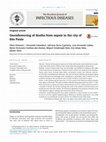
The Brazilian journal of infectious diseases : an official publication of the Brazilian Society of Infectious Diseases, Jan 2, 2016
The aim of the present study was to obtain information about deaths due to sepsis in São Paulo fr... more The aim of the present study was to obtain information about deaths due to sepsis in São Paulo from 2004 to 2009 and their relationship with geographical distribution. Causes of death, both main and secondary, were defined according to the codes of the International Classification of Disease version 10 (ICD-10) contained in the database. Sepsis, septic shock, multiple organ failure, pneumonia, urinary tract infection, peritonitis and other intraabdominal infections, skin and soft tissue infections (including surgical wound infection) and meningitis were considered as immediate cause of death or as the condition leading to the immediate cause of death related or associated to sepsis. In the analyzed period, there was a 15.3% increase in the absolute number of deaths from sepsis in São Paulo. The mean number of deaths during this period was 28,472±1566. Most deaths due to sepsis and sepsis-related diseases over the studied period occurred in a hospital or health care facility, showing...
J Bras Nefrol, Mar 1, 2003

Einstein (São Paulo), 2011
Objective: Reuse of hemodialysis filters is a standard practice and the sterilizing chemical most... more Objective: Reuse of hemodialysis filters is a standard practice and the sterilizing chemical most often employed is peracetic acid. Before starting the dialysis session, filters and lines are checked for residual levels of peracetic acid by means of a non-quantitative colorimetric test that is visually interpreted. The objective of this study was to investigate a new quantitative spectrophotometric test for detection of peracetic acid residues. Methods: Peracetic acid solutions were prepared in concentrations ranging from 0.01 to 10 ppm. A reagent (potassium-titanium oxide + sulfuric acid) was added to each sample in proportions varying from 0.08 to 2.00 drops/mL of solution. Optical densities were determined in a spectrophotometer using a 405-nm filter and subjected to visual qualitative test by different observers. Results: A relation between peroxide concentrations and respective optical densities was observed and it was linear with R2…

International journal of stroke : official journal of the International Stroke Society, Jan 9, 2015
The role of socioeconomic status in the worldwide stroke burden has been studied with various met... more The role of socioeconomic status in the worldwide stroke burden has been studied with various methods using vital statistics and research-generated data. The objective of our study was to describe the stroke mortality rates and the stroke mortality distribution, and to evaluate the association between stroke mortality rates and geographical distribution with the human development index in São Paulo, Brazil. This ecological study evaluated a historical series of stroke mortality in São Paulo, Brazil, from 2004 to 2010. Standard stroke mortality rate per 100 000 inhabitants at each year, the address of residence assumed as the place of living, and the human development index applied as a social indicator were used in order to evaluate if stroke mortality correlated with socioeconomic status. The mean standardized stroke mortality in São Paulo decreased from 66 to 46·7 per 100 000 inhabitants from 2004 to 2010. Stroke mortality differed according to human development index strata with ...







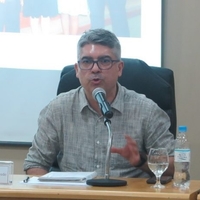

Uploads
Papers by Bento Fortunato Cardoso dos Santos